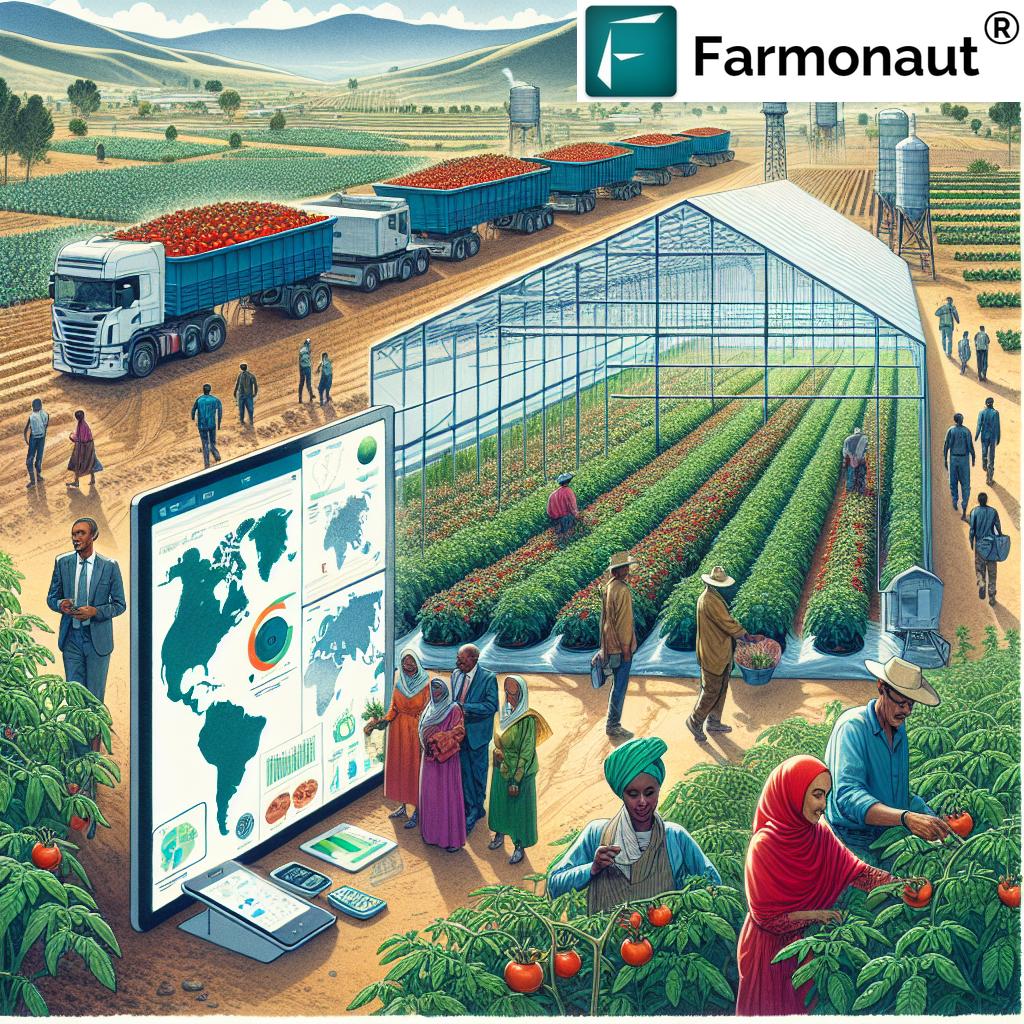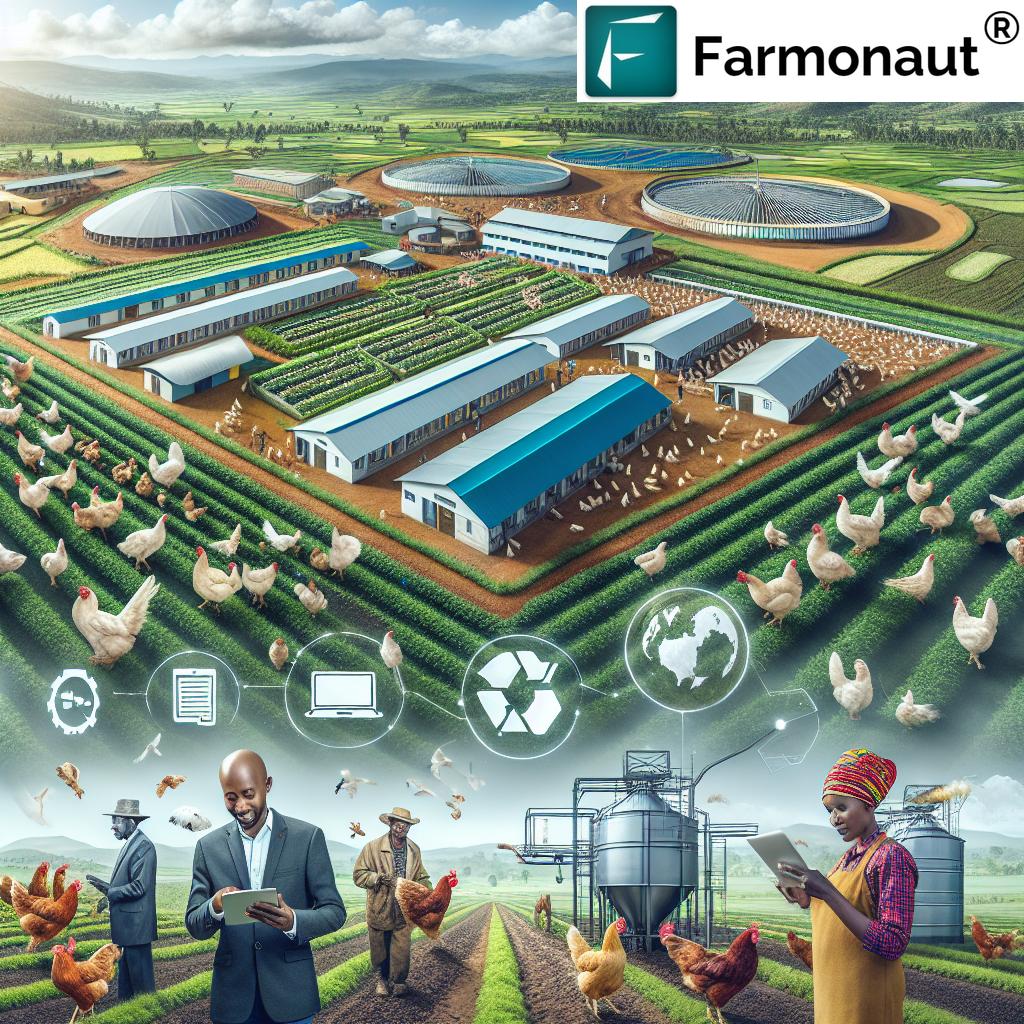Ethiopia Emerges as Key Tomato Supplier Amid Climate-Induced Shortages in Kenya: Market Trends and Price Analysis

“Kenya’s tomato prices surged by up to 300% due to recent rainfall pattern changes, forcing traders to import from Ethiopia.”
In recent months, we’ve witnessed a significant shift in the tomato market trends across East Africa, particularly in Kenya. The impact of climate change on agriculture has become increasingly apparent, reshaping the landscape of tomato production and trade in the region. As we delve into this complex issue, we’ll explore how Ethiopia has emerged as a crucial supplier for Kenya’s tomato market, analyze the factors driving these changes, and discuss potential solutions for a more resilient agricultural future.
The Perfect Storm: Climate Change and Tomato Shortages
The tomato, a staple in Kenyan cuisine and a vital source of income for many farmers, has been at the center of a perfect storm created by changing weather patterns. Recent alterations in rainfall have led to a surge in tomato prices, forcing Kenyan traders to look beyond their borders for alternatives. This situation has opened up new opportunities for Ethiopian farmers, who are now stepping in to fill the supply gap.
- Rainfall patterns in Kenya have become increasingly erratic
- Local tomato production has been severely impacted
- Prices have skyrocketed, affecting both consumers and businesses
- Ethiopian imports have become a lifeline for the Kenyan market
To better understand the complexities of this situation, let’s take a closer look at the optimal conditions for tomato growth and how climate change is disrupting these delicate balances.
Optimal Tomato Growth Conditions
Tomatoes are a versatile crop, but they thrive under specific conditions. Understanding these requirements helps us appreciate the challenges posed by changing climate patterns:
- Temperature: Tomatoes grow best in temperatures between 18-29 degrees Celsius (65-85°F)
- Water: Consistent moisture is crucial, with 1-2 inches of water per week
- Soil: Well-draining, slightly acidic soil (pH 6.0-6.8) is ideal
- Sunlight: At least 6-8 hours of direct sunlight daily
These conditions have historically been met in many parts of Kenya, making it an excellent location for tomato cultivation. However, climate change is altering this delicate balance.
Climate Change Impact on Kenyan Tomato Production
The effects of climatic change on Kenya’s tomato sector have been profound and multifaceted:
- Irregular Rainfall: Unpredictable rain patterns have led to both drought and flooding, affecting crop yields
- Temperature Fluctuations: Extreme heat waves and unexpected cold snaps stress tomato plants
- Pest Prevalence: Changing conditions have altered pest lifecycles, leading to increased infestations
- Soil Degradation: Erosion and nutrient depletion due to extreme weather events
These factors have culminated in reduced yields and quality, pushing prices upward and necessitating imports from neighboring countries like Ethiopia.
Ethiopia’s Rise as a Key Tomato Supplier
As Kenya grapples with these challenges, Ethiopia has stepped up to become a crucial source of tomatoes for the Kenyan market. Several factors have contributed to Ethiopia’s success in this arena:
- Diverse Climatic Zones: Ethiopia’s varied landscape allows for year-round tomato production
- Investment in Agriculture: The country has focused on modernizing farming practices
- Water Resources: Better access to irrigation systems in some regions
- Lower Production Costs: Enabling competitive pricing in the Kenyan market
The shift towards Ethiopian imports has been rapid and significant, highlighting the interconnectedness of regional agricultural markets and the need for adaptive strategies in the face of climate change.
Market Dynamics and Price Fluctuations
The tomato market in Kenya has experienced unprecedented volatility due to these changes. Let’s examine the key trends:
| Month | Average Tomato Price in Kenya (per kg) | Average Tomato Price in Ethiopia (per kg) | Price Difference (%) | Estimated Import Volume from Ethiopia to Kenya (tons) | Notable Weather Events in Kenya |
|---|---|---|---|---|---|
| January | KES 80 | KES 60 | 33.33% | 500 | Dry spell |
| February | KES 100 | KES 65 | 53.85% | 750 | Continued drought |
| March | KES 120 | KES 70 | 71.43% | 1000 | Late onset of long rains |
| April | KES 150 | KES 75 | 100% | 1500 | Heavy rains causing flooding |
| May | KES 180 | KES 80 | 125% | 2000 | Erratic rainfall patterns |
| June | KES 200 | KES 85 | 135.29% | 2500 | Short dry spell |
| July | KES 220 | KES 90 | 144.44% | 3000 | Cool temperatures |
| August | KES 240 | KES 95 | 152.63% | 3500 | Mild drought conditions |
| September | KES 260 | KES 100 | 160% | 4000 | Late short rains |
| October | KES 280 | KES 105 | 166.67% | 4500 | Heavy rains |
| November | KES 300 | KES 110 | 172.73% | 5000 | Flooding in some areas |
| December | KES 320 | KES 115 | 178.26% | 5500 | Unpredictable weather patterns |
This data clearly illustrates the growing price disparity between Kenyan and Ethiopian tomatoes, as well as the increasing reliance on imports to meet local demand.
“Ethiopia has emerged as a key tomato supplier to Kenya, with imports increasing by 150% in the past year.”
Challenges for Kenyan Farmers and Consumers
The current situation presents numerous challenges for stakeholders in Kenya’s tomato sector:
- Farmers: Reduced yields, increased production costs, and competition from imports
- Consumers: Higher prices affecting household budgets and nutritional intake
- Retailers: Unpredictable supply and price volatility impacting business stability
- Policymakers: Balancing food security, farmer support, and trade relationships
Addressing these challenges requires a multifaceted approach that combines immediate relief measures with long-term strategies for agricultural resilience.
Sustainable Farming Practices for Climate Adaptation
To mitigate the impact of climate change on tomato production, Kenyan farmers are exploring various sustainable farming practices:
- Water Management: Implementing efficient irrigation systems and water harvesting techniques
- Soil Conservation: Employing methods like mulching and crop rotation to maintain soil health
- Pest Management: Adopting Integrated Pest Management (IPM) strategies to reduce chemical use
- Crop Diversification: Planting a variety of crops to spread risk and improve soil fertility
- Protected Cultivation: Using greenhouses or shade nets to control growing conditions
These practices not only help in adapting to changing climate conditions but also contribute to more sustainable and resilient agricultural systems.
Agritech Solutions for Climate Adaptation
Technology is playing an increasingly important role in helping farmers adapt to climate change. Some key agritech solutions include:
- Satellite-Based Crop Monitoring: Using remote sensing to track crop health and predict yields
- Precision Agriculture: Employing data-driven techniques for optimal resource use
- Climate-Smart Varieties: Developing and using tomato varieties resistant to heat and drought
- Mobile Apps: Providing farmers with real-time weather data and agronomic advice
These technological advancements are empowering farmers to make more informed decisions and adapt their practices to changing conditions.
Regional Cooperation and Trade Dynamics
The current situation highlights the importance of regional cooperation in addressing food security challenges:
- Trade Agreements: Facilitating smoother cross-border trade in agricultural products
- Knowledge Sharing: Exchanging best practices and research findings between countries
- Infrastructure Development: Improving transportation and storage facilities for perishable goods
- Joint Climate Initiatives: Collaborating on regional climate adaptation strategies
By working together, countries in East Africa can build more resilient food systems that benefit farmers and consumers alike.
Policy Implications and Government Interventions
Addressing the challenges in the tomato sector requires thoughtful policy interventions. Some key areas for consideration include:
- Agricultural Subsidies: Providing support for farmers to adopt climate-resilient practices
- Research Funding: Investing in the development of drought-resistant tomato varieties
- Trade Policy: Balancing the need for imports with protection for local farmers
- Climate Change Mitigation: Implementing broader policies to address the root causes of climate change
Effective policies can help create an enabling environment for sustainable tomato production and ensure food security for the region.
Future Outlook and Potential Solutions
As we look to the future, several strategies could help stabilize the tomato market and improve resilience:
- Capacity Building: Training farmers in climate-smart agricultural techniques
- Market Diversification: Exploring new markets and value-added tomato products
- Weather Insurance: Developing innovative insurance products for smallholder farmers
- Urban Farming: Promoting urban agriculture to reduce transportation costs and emissions
By implementing these strategies, we can work towards a more stable and sustainable tomato sector in Kenya and the broader East African region.
Conclusion
The emergence of Ethiopia as a key tomato supplier to Kenya amidst climate-induced shortages highlights the complex interplay between climate change, agricultural production, and regional trade dynamics. While the current situation poses significant challenges for Kenyan farmers and consumers, it also presents opportunities for innovation, collaboration, and sustainable development.
By embracing sustainable farming practices, leveraging agritech solutions, and fostering regional cooperation, we can work towards a more resilient and productive tomato sector. As we continue to navigate the impacts of climate change on agriculture, it’s clear that adaptability, innovation, and collaboration will be key to ensuring food security and economic stability in the region.
The journey ahead may be challenging, but with concerted efforts from farmers, policymakers, researchers, and consumers, we can cultivate a more sustainable and prosperous future for tomato production in East Africa.
FAQ Section
- Q: What are the main factors contributing to tomato shortages in Kenya?
A: The main factors include irregular rainfall patterns, temperature fluctuations, increased pest prevalence, and soil degradation due to climate change. - Q: How has Ethiopia managed to become a key tomato supplier to Kenya?
A: Ethiopia’s success is due to its diverse climatic zones allowing year-round production, investment in agriculture, better access to water resources, and lower production costs. - Q: What are some sustainable farming practices that can help mitigate the impact of climate change on tomato production?
A: Key practices include efficient water management, soil conservation techniques, integrated pest management, crop diversification, and protected cultivation methods. - Q: How can technology help farmers adapt to changing climate conditions?
A: Technology can assist through satellite-based crop monitoring, precision agriculture techniques, development of climate-smart varieties, and mobile apps providing real-time weather data and agronomic advice. - Q: What policy interventions could help address the challenges in the tomato sector?
A: Important policy areas include agricultural subsidies for climate-resilient practices, research funding for drought-resistant varieties, balanced trade policies, and broader climate change mitigation efforts.

















